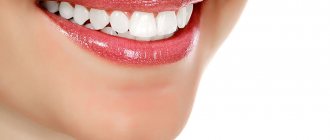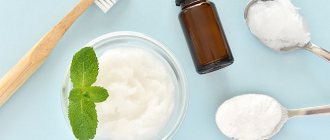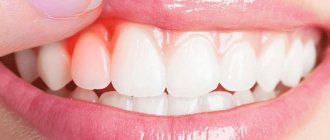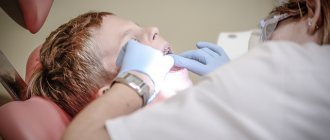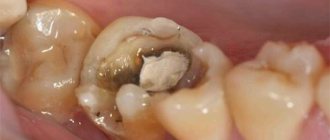Mechanical damage to a tooth due to injury without violating its integrity is called a bruise. This type of injury is common in children and adults, especially athletes. According to statistics, among all injuries to primary teeth, bruises account for 2.5%; bruises of permanent teeth account for 1.5% of the total number of traumatic injuries in the permanent dentition.
Even if the tooth looks unchanged after a bruise, it is necessary to visit a dentist to prevent the development of complications associated with the injury.
Symptoms
A strong blow to a tooth is accompanied by damage to periodontal tissue, and some fibers and small blood vessels rupture. There are no visible structural damage to the tooth; upon visual inspection, it appears intact. After a bruise, the tooth remains motionless, and minor mobility is rarely observed. The gums in the area of the injured tooth swell.
In the first hours after the impact, patients experience pain in the tooth, which intensifies when biting; the pain is aching in nature. The tooth feels high, and slight bleeding may occur from under the gum near it. When a bruise occurs, the neurovascular bundle of the tooth can be damaged, that is, the pulp is injured, and hemorrhage occurs in the pulp chamber, and the enamel becomes pink in color. A severe bruise can lead to the death of the pulp.
Often, when a bruise occurs, cracks appear on the tooth enamel, which can only be detected with a special examination.
Loose teeth - reasons
The main provoking factors of pathological mobility of dental units can be:
- Inflammatory and non-inflammatory gum diseases - gingivitis, periodontitis, periodontal disease. One of the most common causes of mobility.
- Chronic diseases: psoriasis, diabetes, thyroid dysfunction, some types of metabolic disorders, arthritis, osteoporosis.
- Disturbances in the functioning of the immune system.
- Bite pathologies.
- Hereditary predisposition.
- Hypovitaminosis and hormonal changes.
- Taking certain medications.
- Advanced root caries and other types of “dental” diseases (periodontitis, cyst, granuloma, etc.).
- Injuries, bruxism, unhealthy diet, bad habits.
In addition, in cases where the front teeth are loose, we can talk about non-compliance with hygiene standards - in the absence of proper care, hard plaque accumulates in the root part of the teeth, which gradually provokes inflammation of the gums and disruption of the dentogingival bonds.
If you have a problem similar to that described in this article, be sure to contact our specialists. Don't diagnose yourself!
Why you should call us now:
- We will answer all your questions in 3 minutes
- Free consultation
- The average work experience of doctors is 12 years
- Convenient location of clinics
Single contact phone number: +7
Make an appointment
Having noticed the high mobility of their own dental units, many people are interested: if a tooth is loose, can it be saved? It all depends on the cause of mobility, the degree of oral health and the general condition of the body. In any case, timely visit to the dentist significantly increases the chances of preventing edentia.
Diagnostics
- Patients with a tooth injury are referred for x-ray diagnostics to exclude a root fracture. To obtain information using targeted radiography, it is sometimes necessary to take several images from different angles, which is undesirable for the patient.
The most accurate information about the condition of the roots is provided by computed tomography - an x-ray examination method that allows you to obtain a three-dimensional image of the tooth. The examination results are displayed on the computer screen and must be transferred to a CD or USB flash drive.
An X-ray examination of a tooth bruise reveals a slight widening of the periodontal fissure.
- The condition of the pulp after injury is monitored using EDI - electroodontodiagnosis. The method consists in determining the reaction of the nerve endings of the pulp to the influence of electric current. The level of electrical excitability of the pulp depends not only on its condition, but also on the degree of formation of the tooth root.
The examination is carried out 2 or 3 days after the injury, since on the first day the pulpal response may be reduced due to traumatic neuritis. Be sure to perform an electrical test on adjacent healthy teeth to compare sensitivity levels. 3-4 weeks after the injury, EDI is repeated.
- Another method of examination for a tooth bruise is transillumination, the essence of which is to pass a beam of cold light through the tooth and evaluate shadow formation. If there are cracks in the enamel after an impact, they will be clearly visible in the stream of light; The technique also helps to detect pulpitis. In modern clinics, all dental units are equipped with light guides for transillumination examination.
Tooth bruise - what to do?
Please note that it is impossible to determine the severity of the injuries yourself. A complete diagnosis must include an x-ray and a professional examination in a dental office. At home, an experienced dentist can examine the damage and make certain assumptions, but even without the necessary tools, he will not be able to make an accurate diagnosis.
If it is obvious that the tooth bruise is quite serious, self-treatment is unacceptable. To ease the pain, you can apply ice or just a cold object and go to the dentist as quickly as possible. If it looks like the jaw is damaged, it is advisable to fix it with a bandage. It is advisable that someone accompany the victim, since he may lose consciousness on the road.
Complications after injury
With bruises, the prognosis is usually favorable, but in some cases the injury can lead to the following complications:
- Darkening of the enamel. After a bruise, the cause of darkening is hemorrhage into the pulp chamber: the pink color of the tooth darkens over time, the enamel acquires a brownish or gray tint. Depulped teeth tend to darken due to the fact that metabolic processes in them stop, the teeth become “dead”, and the enamel becomes dull.
- The death of the pulp leads to the development of pulpitis: the pulp decomposes, inflammation develops in the tooth, which without treatment turns into periodontitis.
- Periodontitis is inflammation of periodontal tissue. It can be: post-traumatic, occurring a short time after the injury; chronic, develop as a consequence of pulpitis. When a purulent infection occurs, there is a high risk of tooth loss and purulent blood poisoning.
- The appearance of a post-traumatic odontogenic cyst at the root apex during the development of post-traumatic periodontitis.
- Stopping the development of roots of permanent teeth in children.
- In case of injury to milk teeth, the following are possible: disruption of the formation of the rudiments of permanent teeth, their death.
Where to go with a dental injury
But if you have already provided first aid to a child or adult for a tooth injury, then why also contact a dentist? The fact is that there are damages that cannot be seen with the naked eye - for example, a fracture of the tooth root inside the bone, fractures of the jaw bones and the walls of the tooth socket. Even after successfully placing the tooth back into the socket, splinting is necessary - this is the temporary stabilization of the tooth using a wire that is attached to adjacent teeth. In some cases, it is necessary to suture the edges of the wound or prescribe antibiotics.
If you ignore the problem and do not consult a doctor on time (or do not visit the clinic at all), complications will arise. The tooth may darken, become mobile, and the most common complication after a tooth injury is pulp necrosis, in which the neurovascular bundle inside the tooth dies. The dentist uses special tests to determine the vitality and condition of the pulp. Leaving dead tissue inside a tooth can lead to tooth root resorption as the body begins to perceive it as a foreign body due to infection. This leads to tooth loss in a fairly short time. This is why it is very important to have your teeth examined by specialists after an injury.
Treatment
- For mild bruises, treatment consists of resting the tooth for 3-4 weeks by reducing the load during chewing: the menu includes soft and semi-liquid foods, and a blender is used to grind hard foods.
- To ensure rest for baby teeth, temporary bite separation with the help of mouth guards is used; if a permanent tooth is bruised, splinting is performed. The splint allows you to immobilize an injured tooth and redistribute the load during chewing onto healthy teeth.
- If the pulp dies due to an impact, the tooth cavity is opened and the pulp is removed, after which the root canals are filled and a permanent filling is installed. If the crown of a tooth darkens, it can be whitened.
- When a baby tooth is bruised, grinding of the cutting edge of the crown of the antagonist tooth is used to prevent tooth contact and reduce pain. This method is not used for permanent teeth.
- To relieve pain, it is recommended to take an anesthetic tablet (ibuprofen, ketorolac, nimesulide) and apply an anesthetic gel (Dentol, Kamistad) to the gums around the tooth.
- When swelling of the soft tissues of the face accompanies a bruise, cold compresses are applied: a plastic bottle with cold water (not lower than +4°C) is wrapped in a cloth and held on the area of swelling for 15-20 minutes.
- A course of magnetic laser therapy is carried out - a combined effect on injured tissue of a magnetic field and low-intensity laser radiation. The method helps improve healing processes, relieves swelling and inflammation. The course consists of 10 daily procedures lasting 5 minutes.
- UHF therapy is indicated to accelerate tissue regeneration.
Splinting mobile teeth with fiberglass –
Splinting of the lower anterior teeth - if the lower anterior teeth are splinted, then in this case, on the inner surface of, for example, the 4th, 5th or 6th lower anterior teeth, a horizontal groove is first made 1.5-2 mm high and 2 mm deep . Then a solid fiberglass tape is placed in this groove (Fig. 7). After which, the furrow (together with the fiberglass tape located in it) is filled with a light composite.
In Fig. 8-9 you can see what the inner surface of the lower teeth looks like “before and after” splinting.
The number of teeth that are taken into the splint will depend on the condition of the entire group of front teeth. In addition to the most mobile teeth, the splint must include fixed teeth (usually canines). This will relieve the movable cutters, because Thanks to the rigid splint, the fangs will take on most of the chewing pressure.
Splinting of the anterior upper teeth – splinting of the anterior upper teeth is used when teeth are mobile, when there is a threat, or when there is already a fan-shaped discrepancy of the teeth (Fig. 10). In this case, a groove 1.5-2 mm high and 2 mm deep is also drilled in the teeth. However, most often, a groove is drilled on the front surface of the upper teeth (Fig. 11), after which fiberglass tape is placed into it and covered with light-based filling material (Fig. 12-13).
Please note that with the help of filling material it is possible to eliminate wide interdental spaces (Fig. 13). The number of teeth that will be taken into the splint will depend on the clinical picture.
Splinting teeth: photo
Splinting of lateral teeth - if a lateral group of teeth is splinted, then a groove for the fiberglass tape is drilled not on the inner, but on the chewing surface of several teeth. Fiberglass tape is placed in the furrow in the same way and filled with a light composite.
As a result, the effect of splinting is achieved
When the fiberglass tape is illuminated, it turns into a very hard beam that is securely attached to the teeth. The teeth (with the help of such a beam) seem to be interlocked together and, as a rule, completely motionless.
A fiberglass beam on the teeth (splint) also allows you to redistribute the chewing load between the teeth (24stoma.ru). Even when biting on one tooth, the load will be evenly distributed over all teeth included in the splint. This is very important because... With periodontitis, the teeth are not only mobile, but also slightly divergent - they lose contact with each other.
The result of loss of contact between teeth is that each tooth bears the maximum load and is not able to distribute the load between adjacent teeth through such contacts. Under these conditions, bone tissue atrophies much faster. Splinting teeth in such conditions will significantly increase the service life of such teeth and stop (or slow down) bone atrophy.
Prevention
To prevent dental injuries, you must:
- Observe safety precautions at work, arrange the workplace and carry out potentially hazardous work in accordance with established rules.
- Properly equip playrooms for children and supervise children while playing.
- Follow traffic rules and use seat belts when traveling, as even minor emergency braking of the car carries a high risk of injury.
- Avoid conflict situations that lead to fights.
- Ensure the safety of sports games using special equipment (helmets, masks, dental guards).
- Carefully select sports grounds: they must comply with safety requirements.
Splinting of mobile teeth with crowns –
In this case, the teeth are first depulped (root canals are filled) and then ground down for crowns.
After that, crowns “soldered” to each other, for example made of metal ceramics, are put on them (Fig. 14). This splinting option has a significantly longer service life and reliability than fiberglass splinting. However, its cost is higher, and significantly. When splinting 6 front lower teeth with crowns, the cost of a structure of 6 units of metal-ceramics will be from 30 thousand rubles (not taking into account the cost of tooth removal). Splinting with all-ceramic crowns (Fig. 15) is another 2-2.5 times more expensive. However, when splinting distant chewing teeth, where aesthetics are not so important, it is possible to make crowns not from metal-ceramics, but from ordinary metal ones.
Lump on the gum under the tooth
If a lump appears on your gum and it hurts when pressed, you are faced with a complication of one of the dental diseases. The reason may be the formation of a gingival fistula. Its typical sign is a white dot at the top of the swelling. In this case, a focus of inflammation with pus forms inside the gum.
If the roots of the tooth are inflamed and the lump is hard, you are faced with periodontitis. Often the problem occurs on poorly filled teeth. In this case, you may not feel pain, but if a lump forms, contact our clinic as soon as possible.
The lump may also be soft - this is a symptom of periodontitis. A large area of the gum is affected by infection, it penetrates into the gum pockets and causes swelling.
In addition, a lump may occur if you accidentally injured the mucous membrane with a prosthesis. This can happen due to a poorly installed filling; in this case, it most often appears above the gum.
A slight swelling may appear due to brushing your teeth with a hard brush or poor hygiene, but if the lump on the gum hurts and grows, contact your dentist. Home treatment will not help here.
How to prevent tooth mobility
The main root cause of a tooth becoming loose is poor hygiene. Therefore, the main prevention of oral diseases is double daily brushing with a paste and brush.
You can reduce the likelihood of this phenomenon by other measures:
- using dental floss to remove bacteria in the interdental space and prevent the development of infection;
- regular, at least once every 6 months, examination by a dentist will allow you to promptly identify problems and solve them at the initial stage, without complications or consequences;
- reducing sweet foods in the diet - due to the high glucose content, sugar provokes the proliferation of bacteria in the mouth, initiates inflammation, starts decay processes, destroys tooth enamel, and slows down restoration processes;
- taking vitamins, eating fresh fruits and vegetables will normalize metabolic and regenerative processes in the body, increase immunity and reduce the likelihood of developing diseases;
- if the cause of loose teeth is bruxism, you should wear a special mouthguard over your teeth at night; it is made of elastic material, does not cause discomfort, and protects dental units from damage;
- rejection of bad habits;
- regular professional cleaning of the oral cavity with ultrasound or laser.
The earlier a dental problem is identified, the more opportunities there are to preserve the integrity of the dentition and avoid removal. Therefore, at the first signs of looseness, as well as bleeding gums, reactions to hot and cold, or pain, you should immediately visit the dentist and conduct a thorough examination. After all, prevention is much simpler and cheaper than prosthetics.
A man grinds his teeth in his sleep
There are times when a person involuntarily grinds his teeth. The problem is known as bruxism. It mainly occurs in children under 7 years of age. Most often this happens in a dream or during a moment of deep immersion in one’s thoughts. The facial muscles become overstrained, which causes a spasm: the person clenches his teeth tightly. This causes tooth enamel to wear away, jaw joints to wear out and begin to ache, causing headaches and insomnia.
Why do people grind their teeth in their sleep? The main reasons are emotional fatigue that has accumulated during the day, an incorrect bite, due to which the muscles are constantly tense. It may also be due to poor posture, in particular problems in the cervical spine.
You can find out why your teeth grind at night during a comprehensive examination at a dental clinic. We will solve the problem with the help of medicinal drops. These are comfortable plates that you put on your teeth at night. They will help your muscles tone up.
White plaque after tooth extraction
The period after tooth extraction is not the most pleasant in the life of any person. It takes time for the wound to heal. Patients are concerned about the slightest discomfort, including white plaque on the gum after tooth extraction. This is not a cause for concern, but a sign that tissue regeneration is occurring. White plaque on the extracted tooth appears 2-3 days after extraction. Many patients think that this is pus and they try to get rid of the white film on their own. Doing this is strictly prohibited! White plaque on the tooth socket promotes rapid healing of the wound; it forms a protective barrier through which infection does not penetrate.
How is it formed? After a tooth is removed, the blood coagulates, forming a clot. In the first days, we recommend brushing your teeth very carefully, without touching the socket, and prohibit rinsing your mouth so that the clot remains in place. After 3-4 days, the blood clot turns into a white coating (fibrin protein) - this is a kind of protective film that prevents infection.
If something worries you, it is better to come to the clinic and dispel your doubts. You should be wary if the white plaque after wisdom tooth removal has a gray tint, you have a high fever and feel severe pain.
How to cope with pain?
Toothache is always a good reason to see a doctor; it’s worth taking the time to avoid complications!
If professional dental care is not possible, first aid is to relieve pain and minimize inflammation.
Analgesics of various effects used in dentistry - tempalgin, ketorol, nurofen; standard dosage regimen - 1-2 tablets every 4 hours; The effect of the drugs begins within the first 15 minutes and lasts up to 6 hours.
The tooth hurts and festers
If the gums fester under a tooth or near a tooth, this indicates that an infection has penetrated into the soft tissues and an inflammatory process has begun. There are several common diseases that are accompanied by suppuration.
If the inflammation is chronic, the gums peel away from the tooth until noticeable gum pockets form, the cause is periodontitis. Another disease - periostitis - is accompanied by gumboil, in this case the gums near the tooth swell and fester, and acute pain appears. If the inflammatory process is “concentrated” where the root of the tooth is, the problem is most likely periodontitis. If you notice that the gums are festering under a tooth, do not delay visiting the doctor.
What to do if a tooth is festering? Come for a consultation at our clinic. Based on radiography and radiovisiography, the dentist will determine why the gums around the tooth are festering and how to treat the disease. The doctor will remove tartar, disinfect gum pockets, and remove infected tissue. If the problem is a poor-quality filling, he will remove it and clean the root canals, then fill them again. In some cases, surgical treatment is performed, during which the infected part of the root is removed.






